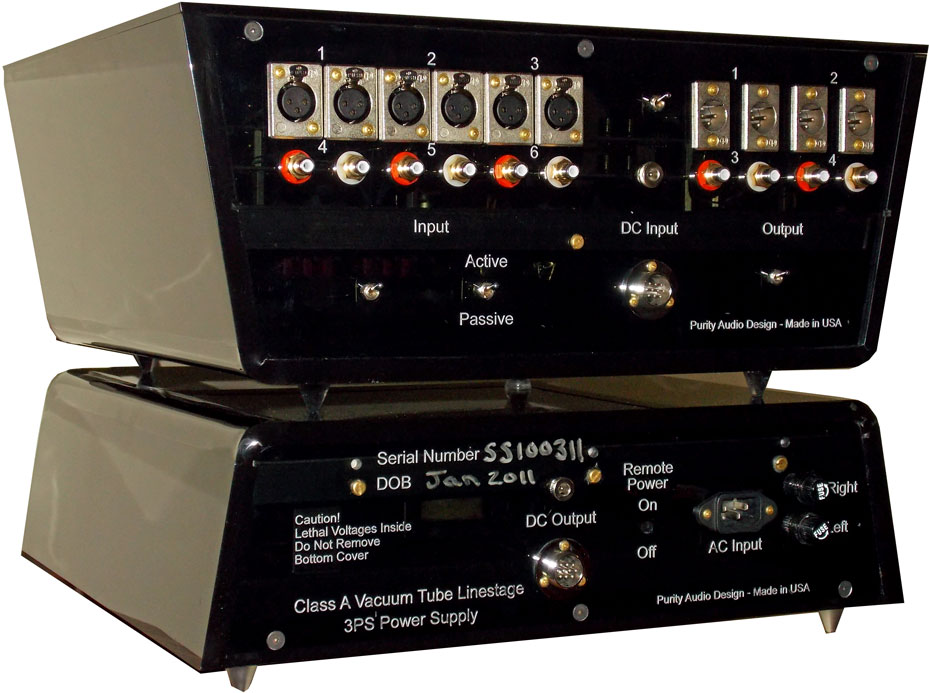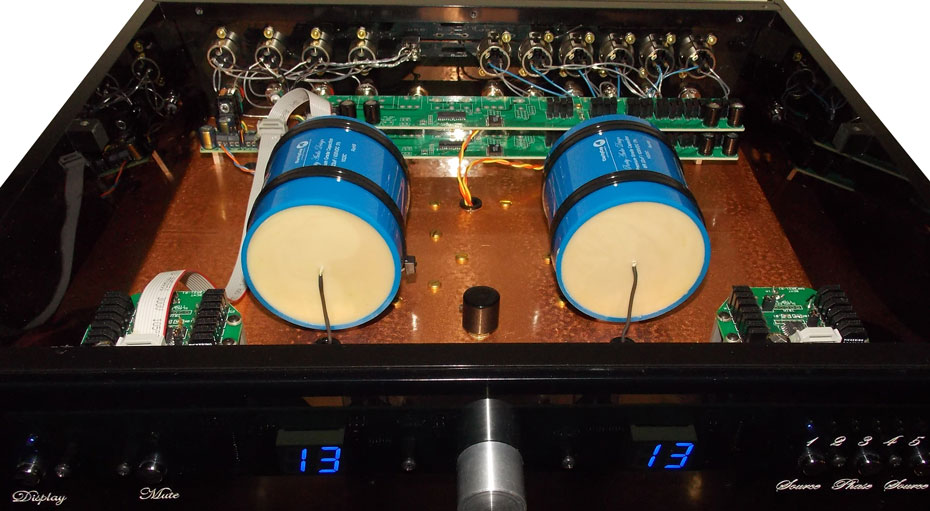Taking the rough edges off the rookie
No rookie is seasoned, and the Silver Statement has a couple rough edges as well. I love the modern build sentiment, but do not like the skiddish, plastic spikes beneath. The linestage is fairly light and if not placed atop the power supply in the notches of its lid prepared for it, the line stage will potentially skate across the shelf when being pushed on it by cable insertion.
The most difficult operational aspect for me to accept on the Silver Statement was noise associated with the attenuation. The Cambridge Audio Azur 840E preamplifier has a laddered resistor attenuator which clacks noticeably when the level is changed. The clack grows louder with the increased level. Similarly, the streamlined circuit of the Silver Statement allows the 1dB increments of the volume control to be heard as popping which increases with intensity as the digital readout on the face of the unit reaches 30dB or beyond. By the time the unit has reached the 40dB range, the intensity of the popping is concerning in terms of the effect, especially upon the tweeter.
This reminds me of the Naim Nait 5i that I used to have in my office. The design eschewed soft startup circuitry, so when it was turned on one heard a hearty “thwump” from the speakers, which was quite bothersome. The escalating popping of the Silver Statement is, in my mind, the most disturbing operational drawback of the unit. The internal autoformer was helpful in reducing this effect, but did not eliminate it.
I hasten to add two points:
1. I do not play music at “live” or concert levels typically. I believe the intensity of the popping would have been very concerning had I been driving my speakers harder. Would I live with such an idiosyncrasy in a product at the cost and performance level of the Silver Statement? Yes, largely because I do not play music at ear-bleed levels. Over time, I did get used to the popping once I knew that it was not having a deleterious effect on my gear. The audiophile needs to respect that there is a tradeoff being made of no small importance; less circuitry and better sound with momentary irritation, or more circuitry and worse sound without the momentary irritant. I do not know what this unit would sound like with the attenuation muting, but as it is I prefer its performance vastly to all other preamps except the VAC Signature Preamplifier MkII, which I place in the same class sonically.
2. I had no noticeable damage to any of my gear from this quirk of the preamp. I suggest that if you are the kind of person who pushes rigs to the extreme that you consult with Purity about this question.
In addition, the remote is not clearly marked. I have no quibble with the general layout of the remote; it’s the outlier buttons which are not used often that escape memory. Purity would do well to put some identifiers on the remote.
On the plus side, the unit is easy to operate, and offers inverted phase and balance adjustment. It is very agreeable to power cord swapping, and tube rolling is a dream! Joe sent along no less than seven sets of tubes. My life schedule did not cooperate to allow hearing all of them. The Phillips 1963 E80CC was relatively thinner overall with more sibilance and treble emphasis and lighter bass. I found Joe’s favorite, the 12AU7 Baldwin Black Plate, to be a touch too ultra-smooth and missing a bit of bite, however a fantastic choice for completely fatigue-free listening. I most enjoyed the Hammond 12AU7 as vibrant, virile and voluptuous. It was vastly open with not an iota of tubbiness or bloat.
Listening sessions
Everyone has heard Sade’s latest single Soldier of Love, but I thought I would pick up the disc to see what else it contained. She slathers on the bass like a desperate, ghostly Midwesterner slathers on sunscreen while on a mid-Winter trip to Cancun. The bass fairly falls apart from the excessiveness of it. It takes a very good rig to articulate the lowest bass lines of her music. The track “Skin” is a prime example. The Cambridge Audio Azur 840E is a clean preamp, but it sounded rather indistinct on this piece in comparison to the Silver Statement. With the 840E I could determine accurately the quantity (dynamically) of the bass line, but not so much the quality. The Silver Statement allowed a clear grasp of the quantity and quality of the bass. Sade’s voice had a sultry seductiveness through the Purity which was beguiling.
Perhaps my mid-life crisis is buying compact discs. Lately, I find myself scrounging Styx, Chicago, Billy Joel, America, and the like. One of my favorite head-boppin’ songs was the Spinners’ “Rubberband Man”, and I was like a child on Christmas morning opening the big gift when I found a copy of their greatest hits. The real gift was how this and other oldies compilations were treated by the Silver Statement! I thrilled to the depth and richness of this and other old favorites.
Purity Audio Design is an aptly named company if the Silver Statement is representative of their work. Purity is chief among the necessary attributes of a component to enjoy older recordings. If the preamp isn’t pure, then the entire system will taint and occlude the recording. I was surprised how vivid, how recent these recordings sounded, chiefly because the Purity is so pristine that a terrific amount of detail, which is not audible through most preamps, was clearly heard. Consequently, the five part harmony of the Spinners was able to be appreciated. Everyone, regardless of the sound quality of their system, hears the bouncing beat of the song, but only the finest systems open up to reveal the synthesized “twang” in the right channel periodically during the refrain! It is a good impression of a giant rubber band! Minute details flooded my listening room, causing me euphoric enjoyment of the sonic saturation of performances.
Piano through the Purity was as inspiring as I have heard in any system, regardless of cost. With most systems, there is almost always something lacking in reproduction of piano; either the weighting is light or the piano case can’t be heard, or the hammers can never be heard no matter the recording, etc. Nothing, and I do mean nothing was amiss with the combination of the Silver Statement and the Jones Audio M300 monoblock amplifiers mentioned below. At about 1:22 into Mary Chapin Carpenter’s “I Am A Town,” the piano accompaniment reaches such heights that most systems can’t capture the note correctly and only produce a ping. With the Purity, however, the string is vibrating and it was gratifying to hear it as such. It takes extreme quality for a preamp to render such nuances.
Another euphoric moment was hearing Bella Fleck and the Flecktone’s Flight of the Cosmic Hippo such that the electric bass was reverberant. Yes, the bass is echoing off the recording venue’s walls in the background! With a typical high-end preamp, one only hears the immediate note and not the reverberation, but the Silver Statement can isolate the note from the reverberation; consequently the recording goes from being merely spacey to galactic in scale as the piece of music seems to be moving ponderously through space! The Silver Statement reaches exceptionally deep into a recording to pull from it treasures which remain hidden to other preamps.
- ← Previous page
- (Page 2 of 3)
- Next page →



